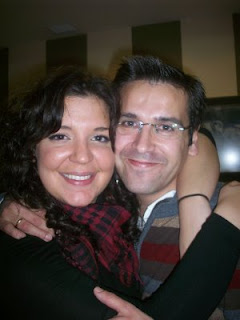Beta plan.
Launch date: June 2, 2020
Vision: To create unique
coursework for English language learners that combines comedy, culturally relevant
content and engaging discourse to help the student learn English in a fun,
dynamic and nontraditional way.
My (working) philosophy on teaching a language is
two-fold:
- Real-life speaking and cultural/societal references
disseminated in an individual/small group setting is essential to truly
understand a language
- A deep understanding and appreciation for a language
comes when the learner is engaged yet relaxed.
While the core components of traditional language learning (repetition, group work and focus on sentence construction and grammar) are important parts of language learning, they only provide the learner with a one-dimensional aspect of the language. In order for someone to truly comprehend and be able to use a language, they must also explore the use of common day-to-day language (ie expressions, slang, swear words) as well as underlying cultural references and the social framework in which the language lies. It is only by exploring these linguistic areas that the learner can get a truly comprehensive sense of a language and its corresponding culture.I also believe it is imperative that classes are created and executed in a way that engages the learner and allows them to learn in a fun and stress-free manner. Because of this, it is important that the teacher customizes lessons to the individual learner. Each student has their own individual learning style, motivations and interests. These factors should be fully considered when deciding on the specific pedagogical approach to use with said student. It is because of this that small group or individual lessons are vastly superior to larger group settings. The benefits of smaller classes are as follows:- The student has individualized and customized content
- The speaking time of the student is significantly
increased
- The student feels less intimidated and less likely to
compare themselves to their peers and therefore feel relaxed and free to
express themselves openly
This, combined with incorporation of other traditional learning techniques, serves to provide a comprehensive and holistic view of a language and its corresponding culture. Only when all these linguistic and cultural facets are deeply explored may the learner be truly proficient in the target language.- Real-life speaking and cultural/societal references
disseminated in an individual/small group setting is essential to truly
understand a language
Website
components:
Start here
(teaching philosophy, tips for studying)
Vocabulary
lists (with corresponding videos and contextual examples)
American
Culture Explained
Advanced Topics (Adults)
Kids section
Aubs travel blog (travels and documenting meeting online students in real life/reconnecting with old students from decades ago)
Topics for lesson plans/discussions*:
- Slang - Modern greetings - Idioms - Swear words (levels of severity/where and when to use them)- Exclamations and filler words - Texting in English - Online dating - Business English - The art of small talk - Navigating embarrassing situations - Dating etiquette/terminology/pet names, etc/do’s and don’t - Pick up lines/how to flirt - How to console someone/grief - Why are Americans so friendly? - Why do Americans dress so casually? - The empty ‘how are you’? - American body language - American accents by region - British English vs American English - Faux pas - Tipping culture/ the culture of customer service - Inside the American house - Food culture (regional) - Guns in America - Trumpism - 2020 Elections - Race tensions - Mental health - The Case of Jussie Smollett - Trayvon Martin - Idiocracy: a look into the decay of American society - Millennials in America - Mass shootings - The case of Chris Watts - College admissions scandal - Hurricane Katrina: A natural and political disaster - Justin Bieber: love to hate him - Puerto Rico and how it fits into America - Celebrity culture - Reality tv culture - Goodfellas: Exploring the Italian-American mafia in cinema - Mennonites and the Amish - 2008 Economic Recession - Opioid crisis - Meth epidemic - Suicide epidemic - Gay in America - Gangs - Rap hip/hop culture - Christmas in America - Cultural appropriation and the art of being politically correct
- Emotions and how to express them (with specific contextual examples
- Slang - Modern greetings - Idioms - Swear words (levels of severity/where and when to use them)- Exclamations and filler words - Texting in English - Online dating - Business English - The art of small talk - Navigating embarrassing situations - Dating etiquette/terminology/pet names, etc/do’s and don’t - Pick up lines/how to flirt - How to console someone/grief - Why are Americans so friendly? - Why do Americans dress so casually? - The empty ‘how are you’? - American body language - American accents by region - British English vs American English - Faux pas - Tipping culture/ the culture of customer service - Inside the American house - Food culture (regional) - Guns in America - Trumpism - 2020 Elections - Race tensions - Mental health - The Case of Jussie Smollett - Trayvon Martin - Idiocracy: a look into the decay of American society - Millennials in America - Mass shootings - The case of Chris Watts - College admissions scandal - Hurricane Katrina: A natural and political disaster - Justin Bieber: love to hate him - Puerto Rico and how it fits into America - Celebrity culture - Reality tv culture - Goodfellas: Exploring the Italian-American mafia in cinema - Mennonites and the Amish - 2008 Economic Recession - Opioid crisis - Meth epidemic - Suicide epidemic - Gay in America - Gangs - Rap hip/hop culture - Christmas in America - Cultural appropriation and the art of being politically correct
- Emotions and how to express them (with specific contextual examples
*These
topics will be presented in a non-biased manner where all sides are
explored. Lesson plans will consist of
original video content, literature, examples, charts and vocabulary lists
created by Aubree as well as relevant articles, videos, graphs, music, films,
etc. The idea is to present a background and cultural content of the topic in a
neutral manner in order for the student to develop their own opinions.











































